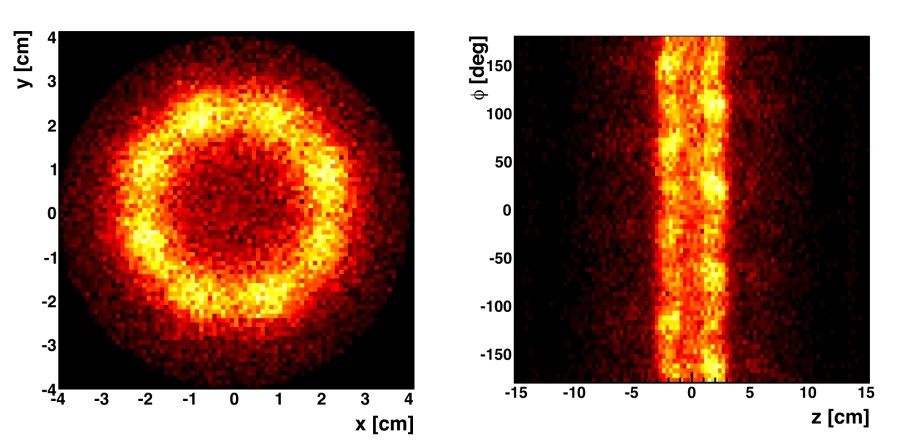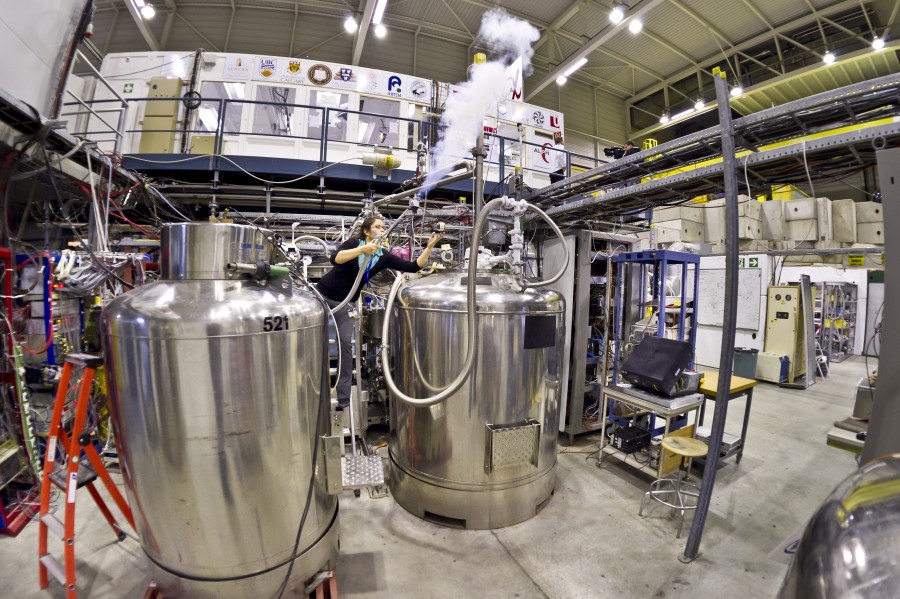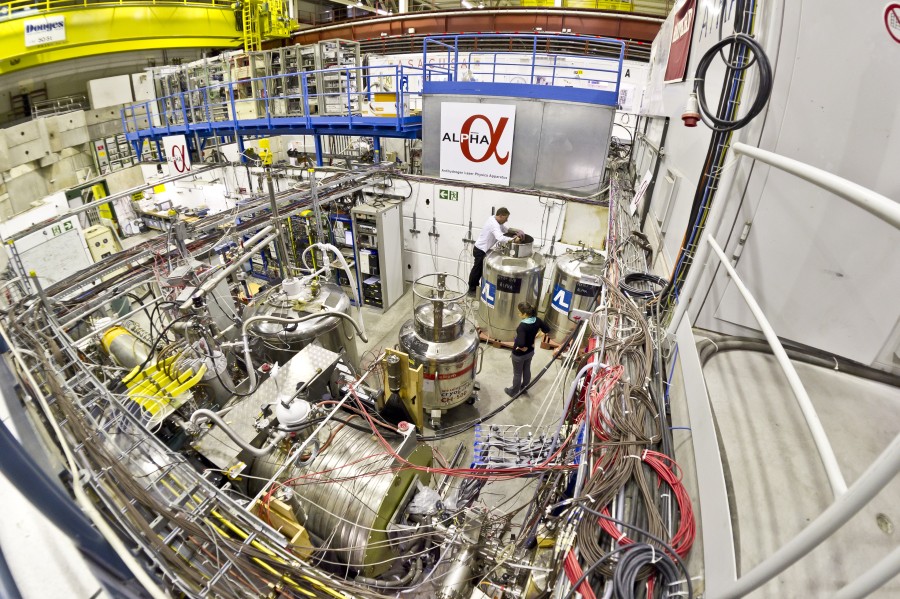Added 2 new A* pages:Science made the news again today! The ALPHA project at CERN--best known for being home to the world's largest particle accelerator--trapped antihydrogen: 38 atoms consisting of a positron orbiting an antiproton were kept intact for about a sixth of a second. Previously, positrons and antiprotons had been created in accelerators, and sometimes combined into antihydrogen, but nobody had been able to keep them around long enough to get a good look at them before they did this:

image by CERN (source)
Those are antihydrogen atoms hitting the side of ALPHA's antimatter trap, which is a Penning trap: it uses strong magnetic fields to keep the positrons and antiprotons inside, away from any regular matter they might hit and annihilate against. Once those particles combine into antihydrogen, though, they become magnetically neutral, and, in previous experiments--according to this helpful article about ALPHA's trap--those antihydrogen atoms would then be loose and annihilate against the side of the trap within microseconds, which wasn't long enough to get a good look at them.
The current goal of CERN's ALPHA ("Antihydrogen Laser Physics Apparatus") experiment is to be able to observe antihydrogen long enough to measure its spectrum, and compare it with hydrogen: they're expected to be the same, but if they aren't, that could lead to an explanation for why we're in a matter rather than antimatter universe!)
That's great, but how do you get these antimatter atoms to stay still for you? ALPHA's solution has been to incorporate a second, very subtle magnetic field, called a "Ioffe–Pritchard field," or a "minimum-B trap," into their Penning trap. What that does gets into quantum mechanical stuff like "magnetic moment" (here, for instance) that I don't really understand, but it *seems* to be something like this: all atoms, neutral or not, have a quantum property, "magnetic moment," of a certain discrete value, and if you can create some slow-moving (ie very cool) atoms inside a very sensitive magnetic field tuned in just a certain way, the intrinsic magnetic moment of the atoms will keep the atoms inside the field--well, still not for very long, but apparently the ALPHA scientists think that the time scales they can keep the antihydrogen atoms in the trap--currently about 1/6th of a second--will be sufficient to start getting some measurements of the antimatter's properties.
CERN has been producing antimatter in accelerators and catching it via their Antiproton decelerator since 2000 (they've been producing it for much longer than that, I think). ALPHA apparently uses evaporative cooling to get their antimatter cool (ie slow) enough to hold in their Ioffe-Pritchard field: you let the hottest atoms escape, and that cools the ones remaining, while of course significantly cutting down your sample size.
At some point they tried using lasers for cooling, and may still for all I know. In laser cooling, you zap atoms from all sides with lasers tuned to a frequency that matches a specific energy level / velocity in the target atoms, so photons in the beam hit those atoms as they're trying to move outward, very gradually slowing them down (if you continue to retune the lasers to lower and lower frequencies) to really low speeds/temperatures. Here's a nifty Sixty Symbols video on it (direct link for RSS readers).
Particles from the decelerator are--maybe initially?--cooled by passing them through foil. According to one of those articles, they also use liquid helium cooling at some stage in the process--this might be some of it boiling off here:

image by CERN (source)
And here's an overview of the ALPHA lab:

image by CERN (source)
Also, check out the ALPHA experiment home page for a rather slow but helpful video showing how it works.
So why is this interesting for A*? Because the speed at which you can move a space ship is limited by the velocity of its exhaust, and the fastest exhaust you can get from say a nuclear engine, while much faster--in theory--than what we've gotten with chemical engines, is still *only* about 10% of the speed of light, because most of the product of nuclear reactions is not released as energy, let alone usable exhaust. Antimatter, on the other hand, annihilates with matter with 100% conversion to energy, and although you lose about 50% of that as eh neutrinos or well something that just shoots right through normal matter and thus can't be used for propulsion, you're still annihilating an equal amount of matter, too, so added together you can get quite a bang for your buck, and exhaust speeds up to something like 30% of the speed of light. (Here's a handy list of various exhaust speeds.)
So antimatter drives could mean 300% faster ships than you could get through nuclear means! Not to mention a lot of power on hand. But so far, anyway, it doesn't really look feasible. For one thing, producing antimatter is--currently, at least--very inefficient and slow. Some quotes from the Wikipedia entry on antimatter:
- "According to CERN, only one part in ten billion (10−10) of the energy invested in the production of antimatter particles can be subsequently retrieved."
- "in 2004, the annual production of antiprotons at CERN was several picograms at a cost of $20 million. This means to produce 1 gram of antimatter, CERN would need to spend 100 quadrillion dollars and run the antimatter factory for 100 billion years."
- "The current antimatter production rate is between 1 and 10 nanograms per year, and this is expected to increase to between 3 and 30 nanograms per year by 2015 or 2020 with new superconducting linear accelerator facilities at CERN and Fermilab."
- "If we could assemble all of the antimatter we've ever made at CERN and annihilate it with matter, we would have enough energy to light a single electric light bulb for a few minutes." (CERN scientist quoted in 2004.)
So getting any really rocket-usable amount together seems altogether out of the picture for the foreseeable future. Even if you could, though, there's the problem of containing it: according to this article I cited earlier, under current trap technology you'd need a trap 100 meters on each side to hold just a milligram of antimatter (which could yield energy equal to about 50 tons of TNT, which is for instance about 0.0008 the destructive power of a modern thermonuclear missile--ie, really not much).
Incidentally, fusion power also has similar containment problems.
Well dang.
So maybe we won't be using it for space ships, but studying it might teach us some elemental things about the nature of the universe, which would still be cool, I guess. :P
|
